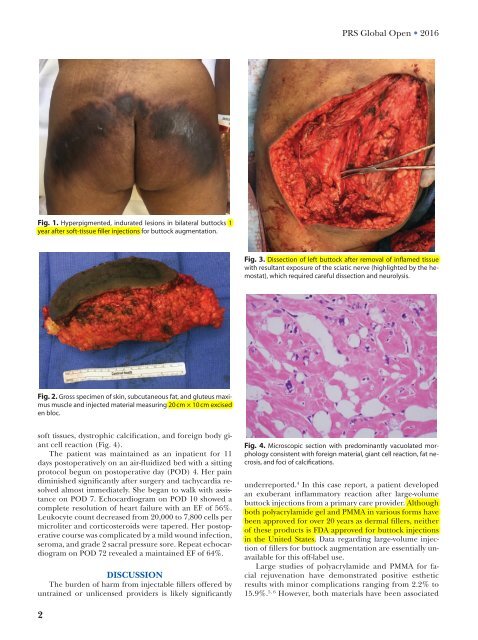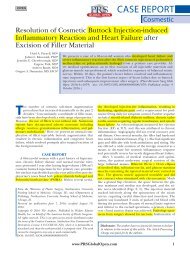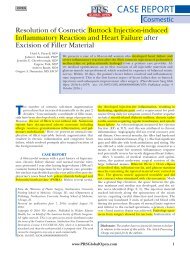PMMA
You also want an ePaper? Increase the reach of your titles
YUMPU automatically turns print PDFs into web optimized ePapers that Google loves.
PRS Global Open • 2016<br />
Fig. 1. Hyperpigmented, indurated lesions in bilateral buttocks 1<br />
year after soft-tissue filler injections for buttock augmentation.<br />
Fig. 3. Dissection of left buttock after removal of inflamed tissue<br />
with resultant exposure of the sciatic nerve (highlighted by the hemostat),<br />
which required careful dissection and neurolysis.<br />
Fig. 2. Gross specimen of skin, subcutaneous fat, and gluteus maximus<br />
muscle and injected material measuring 20 cm × 10 cm excised<br />
en bloc.<br />
soft tissues, dystrophic calcification, and foreign body giant<br />
cell reaction (Fig. 4).<br />
The patient was maintained as an inpatient for 11<br />
days postoperatively on an air-fluidized bed with a sitting<br />
protocol begun on postoperative day (POD) 4. Her pain<br />
diminished significantly after surgery and tachycardia resolved<br />
almost immediately. She began to walk with assistance<br />
on POD 7. Echocardiogram on POD 10 showed a<br />
complete resolution of heart failure with an EF of 56%.<br />
Leukocyte count decreased from 20,000 to 7,800 cells per<br />
microliter and corticosteroids were tapered. Her postoperative<br />
course was complicated by a mild wound infection,<br />
seroma, and grade 2 sacral pressure sore. Repeat echocardiogram<br />
on POD 72 revealed a maintained EF of 64%.<br />
DISCUSSION<br />
The burden of harm from injectable fillers offered by<br />
untrained or unlicensed providers is likely significantly<br />
Fig. 4. Microscopic section with predominantly vacuolated morphology<br />
consistent with foreign material, giant cell reaction, fat necrosis,<br />
and foci of calcifications.<br />
underreported. 4 In this case report, a patient developed<br />
an exuberant inflammatory reaction after large-volume<br />
buttock injections from a primary care provider. Although<br />
both polyacrylamide gel and <strong>PMMA</strong> in various forms have<br />
been approved for over 20 years as dermal fillers, neither<br />
of these products is FDA approved for buttock injections<br />
in the United States. Data regarding large-volume injection<br />
of fillers for buttock augmentation are essentially unavailable<br />
for this off-label use.<br />
Large studies of polyacrylamide and <strong>PMMA</strong> for facial<br />
rejuvenation have demonstrated positive esthetic<br />
results with minor complications ranging from 2.2% to<br />
15.9%. 5, 6 However, both materials have been associated<br />
2




